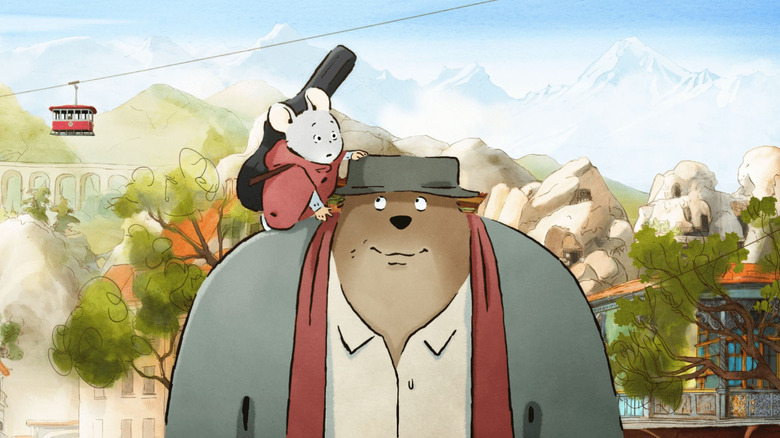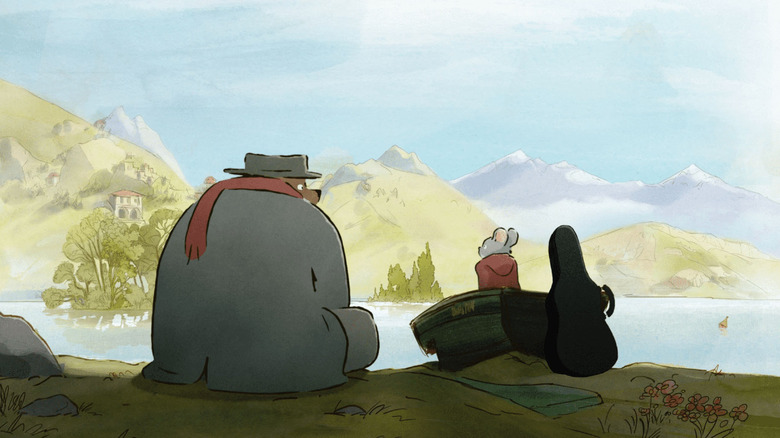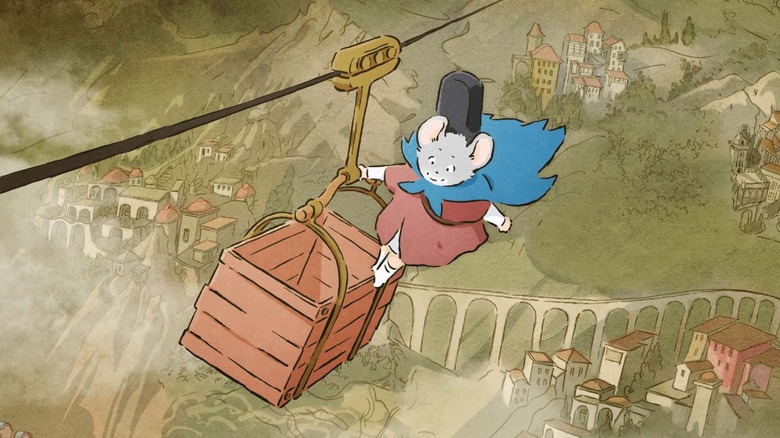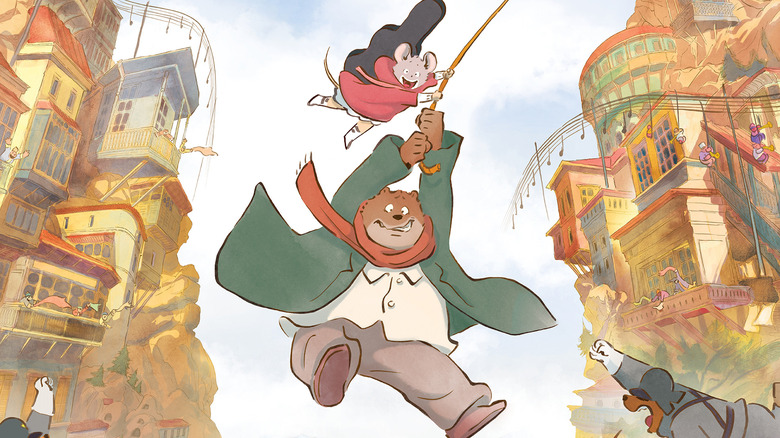Ernest & Celestine: A Trip To Gibberitia Review: Epic Sequel Tackles G-Rated Conformity And Censorship
The French animated film "Ernest & Celestine: A Trip to Gibberitia" executes a music gag you wouldn't expect to be both world-building and silly. With the stoic seriousness of a concert professional, an anthropomorphic bear musician flexes his knuckles over a piano, as if prepping for Sergei Rachmaninoff's "Piano Concerto #2 in C Minor." But instead, he proceeds to plink the C-note repeatedly. There is no variation in the tune except a change in tempo. Then the editing expands the gag by revealing a payoff: the piano really only has one piano key. The crowd lauds his music. The lead bear and mouse, the eponymous Ernest and Celestine, are gobsmacked by this display of "music." At once, they learn the hard way that this country banned multi-note instruments. This gag best represents the family-friendly politics within the "Ernest & Celestine" sequel.
Dare I say the sequel might sing a better tune than the first? It's saying a lot that its own stakes feel special and epic in a way the first film wasn't. This is not a dig at the first 2012 Oscar-nominated "Ernest & Celestine" feature (directed by Stéphane Aubier, Vincent Patar, and Benjamin Renner), which was a delightful buddy-buddy romp about two outsiders coming together. With directors Julien Chheng ("Star Wars: Vision Volume 2") and Jean-Christophe Roger now taking the reins, none of the watercolored warmth is lost in "Ernest & Celestine: A Trip to Gibberitia." Using TVPaint software (which animates plenty of Cartoon Saloon productions), its "tradigital" graphics illuminate a hand-drawn visage with illustrative exuberance. Such colors help render the landscapes and the fuzzy friendship between a bear and mouse.
A bigger adventure
Adapting Gabrielle Vincent's Belgian children's books, the first installment drew out its own social commentary: sworn enemies of different species ("bears above and mice below") can defy the social order and become best friends. Now Ernest (Lambert Wilson), a friendly grump of a troubadour bear, and Celestine (Pauline Brunner), a plucky mouse orphan, confront and rebel against another social order.
Their call to adventure starts out with an innocuous conflict when Celestine accidentally breaks Ernest's beloved violin. The only one who can fix it lives in Ernest's homeland of the bear-populated Gibberitia. Setting up the film's intrigues (script and dialogue by Guillaume Mautalent and Sébastien Oursel), Celestine is confused when Ernest voices reluctance to return to his birth country. Upon arrival, the Gibberitia laws and practices stun them both, especially Ernest, who does and does not recognize the country he left behind.
From there we learn that Ernest absconded from his homeland because his troubadour career defied his expected career as a judge, according to his patrilineal obligations and strict Gibberitian customs. To punish this defiance, Ernest's father (Michel Lerousseau, giving a stern papa bear performance of a lifetime) and his committee of judges enforced the Ernest Law, banning multi-note music across the country. A bear is not even allowed to whistle along with a songbird. The judges give Ernest this ultimatum: They will re-legalize multi-note music if Ernest succumbs to their expectations and attend the initiation ceremony he fled years ago. But it would be at the cost of his dignity and dreams.
A lighthearted immigrant-refugee story
More thoughtful sight gags surface throughout the elaborate Eastern European-inspired Gibberitia landscape (art direction sets by Zaza Et Zyk). For example, Celestine notices how Gibberitian cubs are dressed as their parents' profession, as a symbol of career expectations. In different hands, these metaphors could be heavy-handed but they speak to a child's headspace like a picture book. And never does the lived-in Gibberitia feel reduced to an exotic region through an outsider's eyes.
At the crux of the Gibberitia's kid-friendly politics, Ernest is undergoing emotional turbulence over his homecoming. We understand why Ernest fled, just as we can comprehend how much it pained him to leave behind his family and country. Though a childlike rebel at heart, he's also internalized obedience and could be re-pressured into conforming. Adding a new emotional core to Ernest and Celestine's dynamic is Ernest's fraught relationship with his family. (In another great world-building gag, Ernest's family home is a house literally cut in half, a kid-friendly shorthand to indicate his mother and father's separation.) Celestine is delighted that Ernest has a family, while he is distressed about opening old wounds with them.
Although this sequel focuses on Ernest's background, Celestine plays the important role of the child viewer's surrogate. She's the inquisitive kid puzzled by an unfamiliar region's sense of order. Any kid with an immigrant or refugee parent may detect the link between a loved one's cryptic temperament and the cultural and political atmosphere they may have left behind. To Celestine, exploring Ernest's homeland explains his outlook. When she notices the Gibberitia maxim, "That's just how it is!" she realizes that inspired Ernest's catchphrase. In response, he's mortified that he adopted the very adage he rebelled against, a very recognizable display of cognitive dissonance.
The music plays on
In its own G-rated lightheartedness, "Ernest & Celestine" has something valuable to say about the rebelliousness of artmaking during authoritative political upheaval. To be clear, Gibberitia's anti-music laws work as effectively as the Prohibition era. People — ahem, bears — will still find a way to blow their tubas, play their saxophone, and whistle with songbirds in secret revelry (composer Vincent Courtois pumps up the jauntiness with his Balkan-inspired score). Although the quest was initially about only restoring Ernest's music, it blossoms into a story about restoring music to Ernest's country with systemic change. Gibberitia can thrive if its civilians have the artistic freedom to play many variations of musical notes.
We love Ernest and Celestine, two outsiders inquisitive and frustrated with the absurdities in the world, because they feel a little like us. As computer-generated 3D animation saturates the cinematic market, 2D-styled animation can hit like a refreshing breeze. The color and light of both "Ernest & Celestine" movies invite you into a realm softer than our world, yet just as familiar.
/Film Rating: 9 out of 10
"Ernest & Celestine: A Trip to Gibberitia" will come out in select U.S. theaters on September 1. Visit GKIDS for screening locations.



